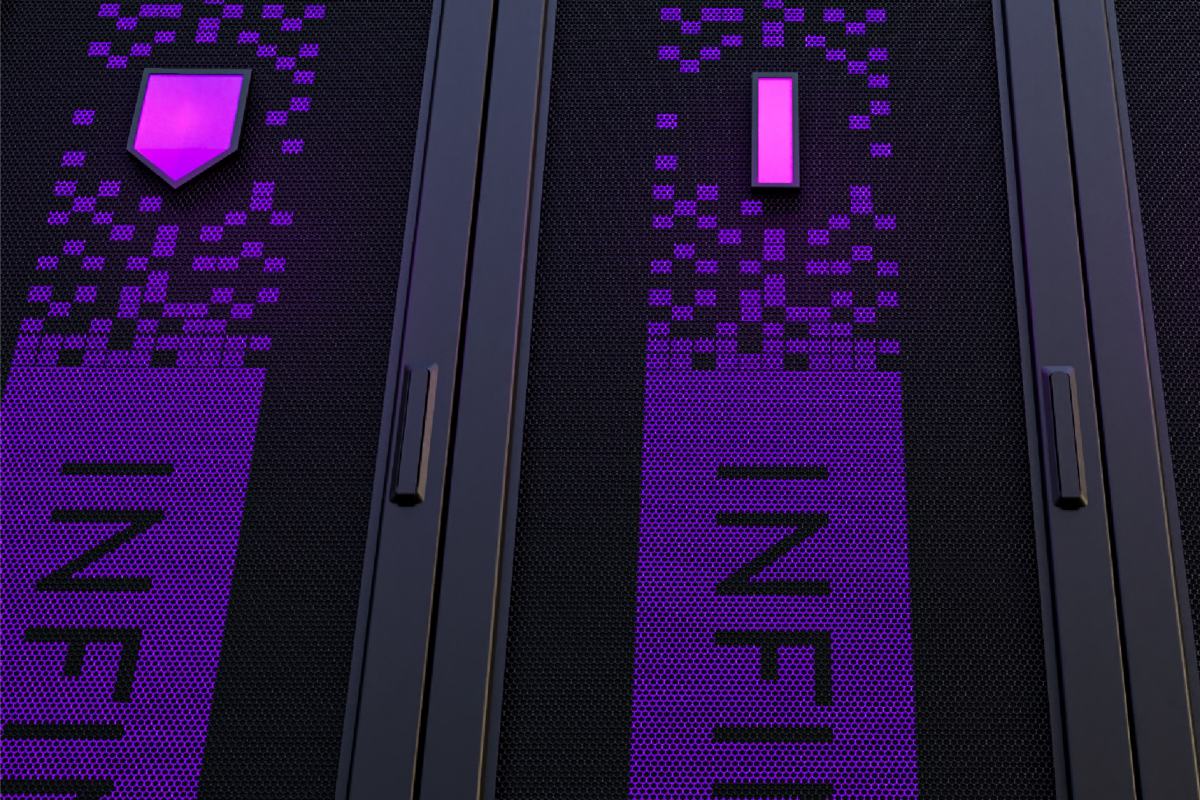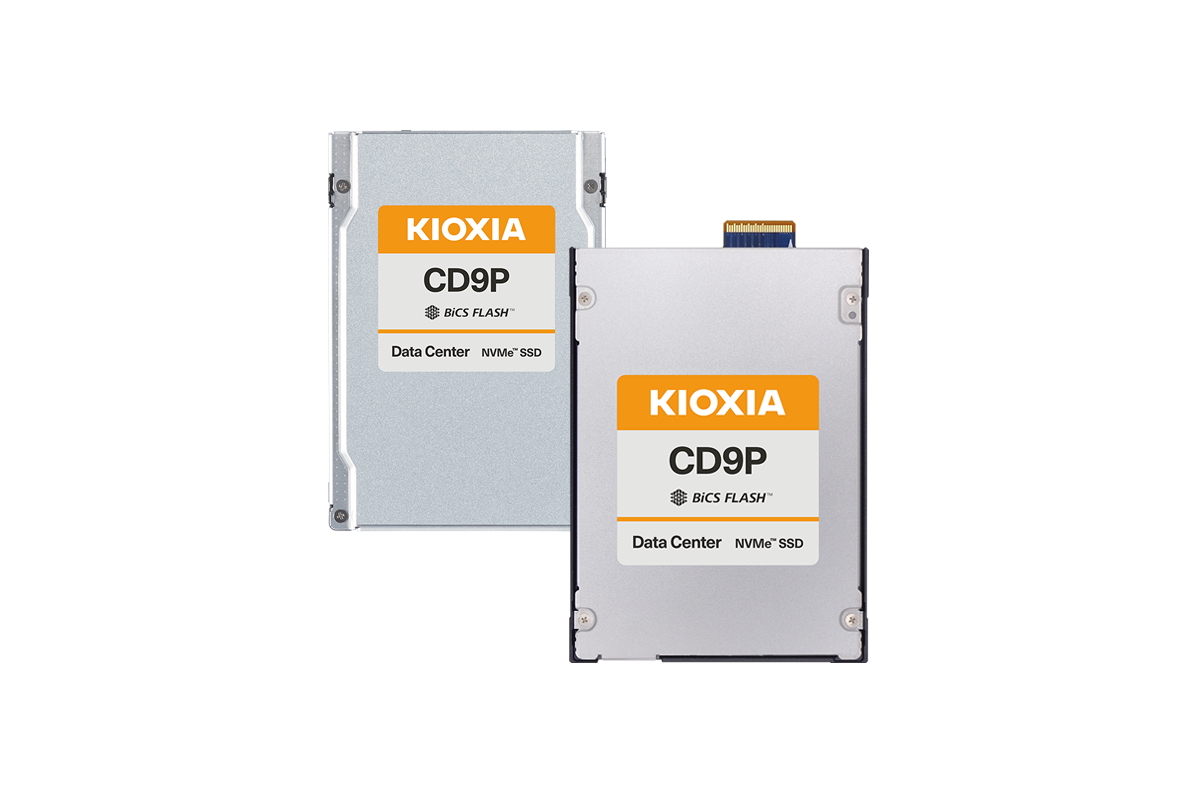Scalable Network Attached Solutions for Modern Infrastructure
Data Centre Infrastructure News & Trends
News
Products
Scalable Network Attached Solutions for Modern Infrastructure
Infinidat expands enterprise storage offerings
Infinidat, a provider of enterprise data storage systems, has announced the expansion of its InfiniBox G4 family of enterprise storage systems with a series of enhancements and a new smaller form-factor model.
The InfiniBox SSA G4 F24 all-flash family aims to deliver high-end storage in a reduced footprint, with improved energy efficiency and a lower entry price point for enterprise storage.
The evolution of the InfiniBox G4 family is hoped by the company to make high-end enterprise storage more accessible to a broader range of enterprises.
Eric Herzog, CMO at Infinidat, says, "We continue to expand and enhance our InfiniBox G4 family, enabling enterprise customers and service providers to store larger quantities of data more efficiently, have easier access to advanced storage capabilities, benefit from flexible capacity management, free up rack space and floorspace, and reduce energy consumption for a greener storage infrastructure at a better power cost-efficiency per terabyte of storage."
Key features of the InfiniBox SSA G4 F24
One of the attributes of the new InfiniBox SSA G4 F24 all-flash family is a 31% smaller physical configuration, intending to achieve a more efficient power profile. The entry price point is also 29% lower than the original small form-factor of the InfiniBox SSA G4.
The system features a 45% reduction in power per petabyte (PBu), which - the company hopes - should mean less power usage, less use of coolant chemicals, and a reduction in greenhouse gas emissions.
Infinidat claims the product offers 28% more capacity in the smaller footprint, up to two times better bandwidth performance, and "over 32% better overall performance."
The full stack of InfiniSafe software's cyber storage security technology comes at no charge with the InfiniBox G4 system.
For more from Infinidat, click here.
Joe Peck - 30 September 2025
Data Centre Infrastructure News & Trends
Enterprise Network Infrastructure: Design, Performance & Security
News
Scalable Network Attached Solutions for Modern Infrastructure
GNM completes 400G infrastructure upgrade in Sofia
GNM (Global Network Management), a backbone internet provider and telecom operator, has completed the modernisation of its point of presence in Sofia, Bulgaria, deploying the Arista 7800R3 - a modular, carrier-grade platform with native 400G capability.
The upgrade is part of GNM’s ongoing strategy to strengthen its optical backbone and meet increasing interconnection demands across south-eastern Europe.
The Sofia node now plays a key role in supporting high-throughput transit traffic from the Balkans, Turkey, the Middle East, and the Caucasus.
With two fully independent DWDM paths - routed via Belgrade and a diverse route through Romania - the site has been engineered to provide path diversity, automated failover, and consistent low-latency performance.
It is fully integrated into GNM’s meshed DWDM backbone, which provides onward connectivity to major European hubs including Bratislava, Frankfurt, Amsterdam, Vienna, Prague, Warsaw, and Stockholm.
The node also offers access to a full range of services, including high-capacity 100G and 400G DWDM transport, direct and remote access to GNM-IX, IP Transit with BGP community-based policy control, and Layer 2 services backed by strict service-level guarantees.
“The Sofia upgrade is an important step in the ongoing development of GNM’s core infrastructure in the region," comments Alex Surkov, Head of Development at GNM.
"One of the first customers to use the new platform was a European network operator that provisioned a 100G DWDM service over both available paths, along with a GNM-IX peering connection.
"The deployment delivered a measurable reduction in latency to Frankfurt, around 18%, and significantly improved recovery times during incidents. It’s a clear example of how infrastructure investment directly enhances service performance for our clients.”
Joe Peck - 12 August 2025
Data Centre Infrastructure News & Trends
News in Cloud Computing & Data Storage
Scalable Network Attached Solutions for Modern Infrastructure
Vawlt 3.2 'supercloud' storage platform launches
Portuguese cloud storage platform Vawlt Technologies has just unveiled Vawlt 3.2, the newest release of its 'supercloud' data storage platform.
The update introduces live, "zero-downtime" cloud switching, expands native coverage to three additional European clouds, brings full MinIO-powered private-cloud integration, and delivers engine optimisations that reportedly cut resource consumption while boosting throughput by up to 40× on high-demand workloads.
New features in Vawlt 3.2 include:
● Switching clouds with "no downtime" – There's the ability to replace underlying clouds on an active Vawlt volume, with data migrating in the background while applications keep running.● Three new EU clouds – Native support for IONOS Cloud, Scaleway, and Impossible Cloud lets organisations build fully EU-resident or mixed-region Supercloud volumes.● MinIO private-cloud integration – On-prem or partner-hosted MinIO clusters now appear in the Vawlt console alongside public clouds for unified policy and data-plane control.● Performance and efficiency boost – The re-engineered storage engine, according to the company, "slashes CPU/RAM needs and delivers up to 40x faster bulk-data transfers on selected workloads."
This release marks a step in Vawlt’s mission to keep data ownership with the organisations that create it. Cloud switching seeks to dissolve vendor lock-in, an expanded roster of EU providers to anchor data inside chosen jurisdictions, and private-cloud onboarding to extend sovereignty to infrastructure businesses already own.
As the EU Data Act’s portability requirements come into force on 12 September 2025, Vawlt 3.2 - the company claims - "equips enterprises to meet the letter of the law while granting operational independence to navigate supply-chain risk [and] shifting regulations."
Ricardo Mendes, CEO & Co-Founder, Vawlt, comments, “True digital freedom is the ability to be independent of cloud providers — including the right to pick the right cloud, or clouds, at any point in time, without fear of downtime, lock-in, or bill shock. Vawlt 3.2 turns that vision into a push-button reality. Whether you’re preparing for the EU Data Act’s portability rules or safeguarding your business against supply-chain risk, you’re now fully in control of where your data lives and how fast it moves.”
Joe Peck - 17 July 2025
Data
Data Centres
News
Scalable Network Attached Solutions for Modern Infrastructure
Chemists create molecular magnet, boosting data storage by 100x
Scientists at The University of Manchester have designed a molecule that can remember magnetic information at the highest temperature ever recorded for this kind of material.
In a boon for the future of data storage technologies, the researchers have made a new single-molecule magnet that retains its magnetic memory up to 100 Kelvin (-173 °C) – around the temperature of the moon at night.
The finding, published in the journal Nature, is a significant advancement on the previous record of 80 Kelvin (-193 °C). While still a long way from working in a standard freezer, or at room temperature, data storage at 100 Kelvin could be feasible in huge data centres, such as those used by Google.
If perfected, these single-molecule magnets could pack vast amounts of information into incredibly small spaces – possibly more than three terabytes of data per square centimetre. That’s around half a million TikTok videos squeezed into a hard drive that’s the size of a postage stamp.
The research was led by The University of Manchester, with computational modelling led by the Australian National University (ANU).
David Mills, Professor of Inorganic Chemistry at The University of Manchester, comments, “This research showcases the power of chemists to deliberately design and build molecules with targeted properties. The results are an exciting prospect for the use of single-molecule magnets in data storage media that is 100 times more dense than the absolute limit of current technologies.
“Although the new magnet still needs cooling far below room temperature, it is now well above the temperature of liquid nitrogen (77 Kelvin), which is a readily available coolant. So, while we won’t be seeing this type of data storage in our mobile phones for a while, it does make storing information in huge data centres more feasible.”
Magnetic materials have long played an important role in data storage technologies. Currently, hard drives store data by magnetising tiny regions made up of many atoms all working together to retain memory. Single-molecule magnets can store information individually and don’t need help from any neighbouring atoms to retain their memory, offering the potential for incredibly high data density. But, until now, the challenge has always been the incredibly cold temperatures needed in order for them to function.
The key to the new magnets’ success is the unique structure, with the element dysprosium located between two nitrogen atoms. These three atoms are arranged almost in a straight line – a configuration predicted to boost magnetic performance, but now realised for the first time.
Usually, when dysprosium is bonded to only two nitrogen atoms it tends to form molecules with more bent or irregular shapes. In the new molecule, the researchers added a chemical group called an alkene that acts like a molecular pin, binding to dysprosium to hold the structure in place.
The team at the Australian National University developed a new theoretical model to simulate the molecule’s magnetic behaviour to allow them to explain why this particular molecular magnet performs so well compared to previous designs.
Now, the researchers will use these results as a blueprint to guide the design of even better molecular magnets.
Joe Peck - 25 June 2025
Data Centre Infrastructure News & Trends
Data Centres
Scalable Network Attached Solutions for Modern Infrastructure
Kioxia broadens portfolio with data centre NVMe SSDs
Kioxia, a Japanese memory manufacturer, formerly the memory business of Toshiba, today announced the development and demonstration of a prototype of its new Kioxia CD9P Series PCIe 5.0 NVMe SSDs. These are the latest SSDs built with Kioxia’s 8th generation BiCS FLASH TLC-based 3D flash memory. BiCS FLASH features CBA (CMOS directly Bonded to Array) technology, an architecture that the company claims 'boosts power efficiency, performance, and storage density, while doubling the capacity available per SSD compared with the previous generation model.'
As GPU-accelerated AI servers drive up the demands on storage infrastructure, maintaining high throughput, low latency, and consistent performance is critical - including keeping GPUs highly utilised. Kioxia claims its CD9P Series is purpose-built for these environments and that it delivers the speed and responsiveness required by AI, machine learning, and high-performance computing workloads.
The CD9P Series leverages Kioxia’s 3D flash memory, featuring a CBA-based architecture that aims to reduce heat generation and enhance thermal management. The company says that the drives deliver 4-corner performance improvements of up to approximately 125% in random write, 30% in random read, 20% sequential read, and 25% in sequential write speeds compared to the previous generation. Furthermore, it claims that performance per watt of power consumption has improved by approximately 60% in sequential read, 45% in sequential write, 55% in random read, and 100% in random write - regarding the 15.36 terabyte model specifically.
Whilst preliminary and subject to change, some features of the Kioxia CD9P Series SSD include:• PCIe 5.0, NVMe 2.0, NVMe-MI 1.2c compliant.• Open Compute Project Datacenter NVMe SSD specification v2.5 support. (Not all requirements.)• Form factors: 2.5-inch 15 mm thickness, EDSFF E3.S.• Read-intensive (1 DWPD) and mixed-use (3 DWPD) endurances.• Sequential performance (128 KiB/QD32) - 14.8 GB/s Read and 7 GB/s Write.• Random performance (4KiB) - 2,600 KIOPS (QD512) Read and 750 KIOPS (QD32) Write.• 2.5-inch capacities up to 61.44 TB and E3.S capacities up to 30.72 TB.• CNSA 2.0 algorithm support.
"Achieving power efficiency, whilst addressing the increasing demand for all data processing challenges for AI, machine learning, or high-performance computing, is possibly the most pressing issue today and in the future," argues Axel Stoermann, Vice President and Chief Technology Officer for Embedded Memory and SSD, Kioxia. "At Kioxia, we are already addressing this need by offering the CD9P Series, a leading power efficiency, high-performance solution delivering speed and responsiveness for high workloads and optimum operation."
Kioxia CD9P Series SSDs are now sampling to select customers and will be showcased at HPE Discover 2025, taking place 23-26 June in Las Vegas, USA.
For more from Kioxia, click here.
Joe Peck - 20 June 2025
Data Centres
Hyperscale Data Centres: Scale, Speed & Strategy
News
Scalable Network Attached Solutions for Modern Infrastructure
Pure Storage and SK Hynix announce collaboration
Pure Storage, a provider of data storage technology and services, today announced a collaboration with SK Hynix, a South Korean semiconductor company, to deliver QLC flash storage products that aim to meet the high-capacity, energy efficient requirements for data-intensive hyperscaler environments.
Modern data centres require solutions that can provide high storage density capabilities without sacrificing performance or energy efficiency. Data bottlenecks can lead to decreased productivity and high energy costs, affecting overall company performance. Traditional storage solutions such as hard disk drives (HDDs) have limitations as they are unable to handle the high-capacity, data-intensive workloads of hyperscale data centres in the AI era.
Pure Storage intend to deliver future DirectFlash Module products with SK Hynix’s QLC NAND flash memory that will be purpose-built for demanding hyperscaler environments. Benefits could include:
• Sustained High Performance — Integrating Pure Storage's data storage platform with SK Hynix's QLC NAND technology to enable low-latency solutions geared towards exascale, data-intensive workloads.
• Increased Energy Efficiency — Collaborating to provide lower energy consumption, helping customers overcome power availability constraints, lower operating costs, and decrease an organisation's overall carbon footprint.
• Improved Scalability & TCO — The combined solution seeks to provide highly rack-dense and scalable systems.
“This collaboration with SK Hynix is an exciting step in our mission to deliver superior all-flash storage technology to hyperscalers. By combining SK Hynix's advanced QLC products with Pure Storage’s host-based flash management architecture, we can deliver an optimised solution for the hyperscale production environment and AI infrastructure,” says Bill Cerreta, GM, Hyperscale, Pure Storage.
“Hyperscalers are constantly searching for data storage technology that doesn’t limit their potential innovation, but propels it to unforeseen levels. SK Hynix's NAND technology, combined with Pure Storage's robust platform, presents a formidable option for data centre operators focused on maximizing performance, efficiency, and scalability. Together, we are empowering hyperscale environments to tackle burgeoning data volumes with cutting-edge, sustainable storage solutions,” comments Sam Lee, EVP, Head of Global Sales and Marketing, SK Hynix.
For more from Pure Storage, click here.
Joe Peck - 29 May 2025
Artificial Intelligence in Data Centre Operations
Cyber Security Insights for Resilient Digital Defence
Data Centre Operations: Optimising Infrastructure for Performance and Reliability
Data Centre Security: Protecting Infrastructure from Physical and Cyber Threats
News
Scalable Network Attached Solutions for Modern Infrastructure
AI set to supercharge cyber threats by 2027
The UK’s National Cyber Security Centre (NCSC) has released a landmark cyber threat assessment, warning that rapid advances in artificial intelligence (AI) will make cyber attacks more frequent, effective and harder to detect by 2027. The digital divide between organisations with the resources to defend against digital threats, and those without, will inevitably increase.
Published on the opening day of CYBERUK, the UK’s flagship cyber security conference, the report outlines how both state and non-state actors are already exploiting AI to increase the speed, scale and sophistication of cyber operations. Generative AI is enabling more convincing phishing attacks and faster malware development. This significantly lowers the barrier to entry for cyber crime and cyber intelligence.
Of particular concern is the rising risk to the UK’s democratic processes, Critical National Infrastructure (CNI) and commercial sectors. Advanced language models and data analysis capabilities are used to craft highly persuasive content, resulting in more frequent attacks that are difficult to detect.
Andy Ward, SVP International at Absolute Security, says, “While AI offers significant opportunities to bolster defences, our research shows 54% of CISOs feel unprepared to respond to AI-enabled threats. That gap in readiness is exactly what attackers will take advantage of."
"To counter this, businesses must go beyond adopting new tools - they need a robust cyber resilience strategy built on real-time visibility, proactive threat detection, and the ability to isolate compromised devices at speed.”
This latest warning forms part of the UK Government’s wider cyber strategy after announcing the new AI Cyber Security Code of Practice earlier this year. This will form the basis of a new global standard to secure AI and ensure national security keeps pace with technological evolution, safeguarding the country against emerging digital threats.
For more from NCSC click here.
DCNN staff - 8 May 2025
Data
Data Centres
News
Scalable Network Attached Solutions for Modern Infrastructure
Innodisk launches SSD series for data centre applications
Innodisk, an industrial-grade flash storage provider, has announced the launch of its latest PCIe Gen5 SSD series, which is designed to meet the OCP Data Centre NVMe SSD spec v2.0 and the increasing demands of AI model training, big data analytics, and data-intensive environments.
The new series supports multiple form factors, including U.2, as well as EDSFF E1.S, E3.S, and the brand new E3.L for data centre applications, catering to the diverse needs of enterprise and data centre environments. Innodisk tells us that the new series marks a new chapter for the company in terms of further fulfilling enterprise demands.
The Innodisk PCIe Gen5 SSD, built with the latest PCIe Gen 5 x4 interface and NVMe 2.0 protocol, is designed to overcome the speed and latency limitations of traditional storage interfaces. With up to 128TB of high density NAND storage, it delivers speeds of up to 14GB/s (read) and 10GB/s (write), enabling lightning-fast data transfers for data-intensive applications.
Enterprise data centres managing large-scale storage deployments and multi-tiered environments often require out-of-band and batch management capabilities, which present growing challenges. Innodisk PCIe Gen5 SSD addresses these demands with NVMe-MI for streamlined SSD management and multi namespace support, ensuring scalable and efficient storage operations.
To ensure high quality and alignment with market trends, the PCIe Gen5 SSD aims to enhance integration with industry-leading data centre standards, such as OCP Data Centre NVMe SSD spec v2.0. Additionally, it is intended to be built for seamless integration with VMware, optimising compatibility with virtualisedenvironments and overall system performance.
Innodisk’s PCIe Gen5 SSD also features advanced security mechanisms, ensuring robust data protection and seamless integration. Secure Boot technology authenticates digital signatures during firmware updates, preventing unauthorised modifications and ensuring that only trusted firmware is executed.
Simon Rowley - 29 April 2025
Data Centres
News
Scalable Network Attached Solutions for Modern Infrastructure
Pure Storage and Micron expand collaboration
Pure Storage, an IT company that delivers advanced data storage technology and services, today announced the expansion of its strategic collaboration with Micron Technology, a global provider of memory and storage solutions. This collaboration enables the high-capacity and energy-efficient solutions that hyperscalers require using Micron G9 QLC NAND for future DirectFlash Module products.
The joint effort continues a decade-long initiative of integrating Micron’s latest NAND technology with Pure Storage products, which spans seven generations and includes the Micron G8 QLC NAND qualified for production in Pure Storage’s 150TB DirectFlash Module. Combined with Pure Storage’s advanced data storage platform, the solution delivers a data storage offering with massive drive capacities, high performance, and low latency - while driving architectural simplification and delivering significant energy efficiency improvements.
In modern data centres, three critical concerns factor into every storage system - energy efficiency, storage density, and performance. Data centres consume tremendous amounts of power, which is why energy-efficient solutions are critical to managing both operational expenses and the impact on the environment. Additionally, as data centres grow, they remain space-constrained, making every square foot valuable. Operators are continuously challenged to fit more storage into less space. Meanwhile, storage performance is even more important as a competitive advantage because consumers of data centre services expect faster data processing, as the rush to turn data into insights accelerates.
Pure Storage and Micron are collaborating to deliver a winning total cost of ownership option versus legacy hard drive-based storage offerings for hyperscalers. The collaboration provides the following benefits:
• Improved performance, lower latency: The combination of Pure Storage’s data storage platform with Micron’s advanced NAND technology with strong transfer rates provides ultrafast, low-latency, and reliable services for massive, data-intensive workloads.• Sustainability: This joint solution dramatically reduces the energy consumption over traditional storage options, lowering operating costs and reducing the environmental footprint.• Rack-dense, scalable options: By integrating Micron’s NAND that offers areal density (bits per square millimetre), Pure Storage can deliver highly scalable systems at a reduced total cost of acquisition and ownership.“Pure Storage’s collaboration with Micron is another example of our significant momentum bringing the benefits of all-flash storage technology to hyperscale environments,” says Bill Cerreta, General Manager, Hyperscale, Pure Storage. “With Micron’s advanced NAND technology, Pure Storage can further optimise storage scalability, performance, and energy efficiency for an industry with unparalleled requirements.”
“Micron’s advanced NAND technologies, combined with Pure’s innovative storage solutions, enable data centre operators to address the increasing performance, efficiency, and scalability needs for today’s hyperscale data centres,” adds Jeremy Werner, SVP & GM, Storage Business Unit, Micron. “Built on trust and thriving on innovation, our collaboration with Pure Storage consistently offers cutting-edge storage solutions for hyperscale and enterprise environments.”
For more from Pure Storage, click here.
Simon Rowley - 7 January 2025
Data Centre Build News & Insights
Data Centre Projects: Infrastructure Builds, Innovations & Updates
Infrastructure Management for Modern Data Centres
News
Scalable Network Attached Solutions for Modern Infrastructure
Pure Storage modernises IT infrastructure for AC Milan
Pure Storage, an IT expert that delivers advanced data storage technologies and services, has announced the modernisation of the IT infrastructure of AC Milan, one of the world’s most historic football clubs.
The club recognised the potential of technology to help it achieve two strategic goals – delivering the best fan experience possible through online content, and providing the team with data and AI to enhance club performance.
At the centre of AC Milan’s fan engagement is its Media House, through which video and social content is produced and delivered. It also supplies critical data to the club’s training centre. The total number of employees and output has risen at the Media House over a three-year period and, as a result, unstructured data volumes had also dramatically increased. Siloed teams, together with a legacy data storage system that was incapable of operating efficiently, posed significant barriers to progress.
By adopting the Pure Storage platform, AC Milan gained a powerful, efficient, and secure storage infrastructure that has underpinned its technology transformation initiative. Benefits include:
• Fast and Reliable, Low Latency Data Storage: With the Pure Storage Platform, AC Milan can now manage large volumes of unstructured data across multiple sites with very low latency, resulting in major productivity improvements. The Media House team now benefits from 10 times faster content production and delivery. This has helped AC Milan reach over 500 million global fans through enhanced digital experiences.• Enhanced Data Security and Ransomware Protection: AC Milan recognises the importance of data resilience, deploying Pure Storage ActiveDR to achieve near zero Recovery Time Objective (RTO) and Recovery Point Objective (RPO) metrics. Additionally, Pure Storage SafeMode Snapshots take copies of data which, in the event of a cyber attack, can’t be deleted, modified, or encrypted, mitigating the impact of a ransomware attack.• A Platform for Cutting-Edge AI Innovation: Video footage of training sessions, stored on the Pure Storage Platform, can be analysed using AI, together with player data captured via sensors with the aim of improving performance. Additionally, AC Milan is developing a data lake composed of players’ medical and performance data with the same goal.
Maurizio Bonomi, Information Technology Director, AC Milan, says, “Our team’s mission is to support the club and the business across all departments so that we’re achieving excellence on and off the pitch. Pure helped AC Milan modernise our Media House so that content can be delivered across multiple platforms in one-tenth of the time that it used to take. The project has been a great success and has marked a new step in our ongoing evolution into a media company.”
Joao Silva, VP EMEA & Latin America, Pure Storage, adds, “We’re thrilled to support AC Milan in its mission to transform the way it connects with fans, and its highly innovative use of AI to improve all-round player performance. The club’s legacy storage couldn’t keep up with its modern, innovative data demands. AC Milan’s Pure Storage platform meets their complex needs. These are cutting-edge initiatives that showcase how the delivery of real time content and AI can benefit football clubs and the welfare of their players.”
For more from Pure Storage, click here.
Simon Rowley - 30 October 2024

Head office & Accounts:
Suite 14, 6-8 Revenge Road, Lordswood
Kent ME5 8UD
T: +44 (0)1634 673163
F: +44 (0)1634 673173









